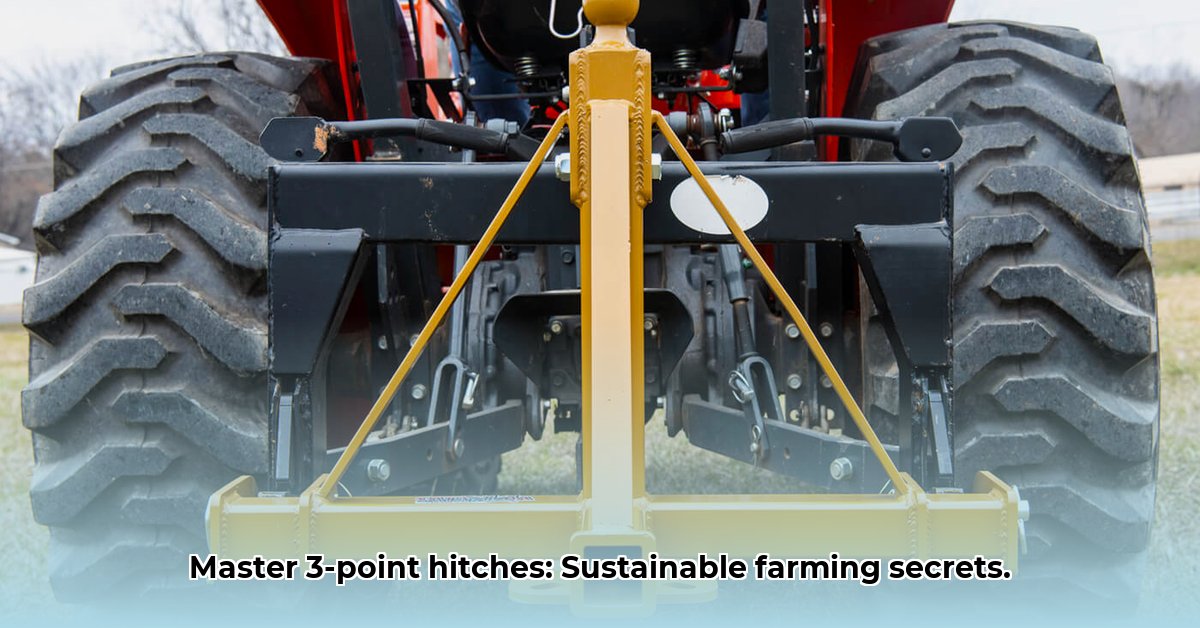
3-Point Tractor Hitch: Your Key to Sustainable Farming
The three-point hitch is a crucial component of modern sustainable farming. This system, connecting implements to your tractor via three points, offers unparalleled versatility and efficiency. It's not simply a convenient tool; it's integral to minimizing environmental impact and maximizing resource use. This guide provides a comprehensive understanding of its use and maintenance. For more on specialized hitches, check out this resource on 3-point grapples.
Understanding Your 3-Point Hitch System
The three-point hitch provides a standardized interface for attaching various implements to your tractor. Two lower links and a top link connect the implement to the tractor’s hydraulic lift, enabling easy raising, lowering, and tilting. This system's simplicity underpins its efficiency and its contribution to sustainable agricultural practices. Using the three-point hitch effectively contributes to environmentally conscious decision-making and enhances land stewardship.
Hitch Categories: Finding the Right Fit
Tractor hitches are categorized (0-4) according to lifting capacity and tractor size. Category 0 hitches are suited for smaller tractors and implements, while Category 4 handles the heaviest equipment. Selecting the correct category is crucial for safety and optimal performance. Mismatching can damage your tractor or render the implement ineffective.
| Hitch Category | Lifting Capacity (lbs) (approximate) | Suitable Tractor Horsepower (HP) | Typical Implements |
|---|---|---|---|
| 0 | Up to 1000 | < 25 | Small tillers, mowers |
| 1 | 1000-2500 | 25-40 | Larger tillers, small planters |
| 2 | 2500-5000 | 40-75 | Medium-size implements, hay rakes |
| 3 | 5000-10000 | 75-125 | Larger planters, balers |
| 4 | 10000+ | 125+ | Heavy-duty implements |
Always consult your tractor's manual for precise specifications. Choosing the incorrect hitch can lead to equipment failure. How can you ensure you're using the right category for maximum efficiency and safety?
Sustainable Farming Practices with Your 3-Point Hitch
The three-point hitch significantly contributes to environmentally responsible farming. Appropriate implements minimize environmental impact:
Reduced Soil Disturbance: No-till seed drills minimize soil degradation, erosion, and improve water retention. This promotes healthier soil and reduces the need for additional resources. What are the long-term benefits of reduced soil disturbance on your farm?
Precision Planting: Precise seed placement optimizes germination, minimizes waste, and boosts yields. This efficiency translates directly to reduced costs and environmental impact. How does precision planting reduce your environmental impact?
Efficient Fertilizer Application: Targeted fertilizer application via spreaders and injectors reduces runoff and pollution, while also improving nutrient uptake. What impact does targeted fertilizer application have on local water quality?
Improved Crop Protection: Efficient and targeted pest and disease control minimizes the spread of harmful substances. What methods can minimize pesticide use while maintaining a healthy crop?
How to Choose the Right 3-Point Tractor Hitch for Sustainable Farming
Selecting the right three-point hitch is pivotal for both efficiency and environmental responsibility. This choice directly influences soil health, fuel consumption, and overall farm sustainability.
Understanding 3-Point Hitch Categories
Hitch categories (0-4) reflect the tractor’s horsepower and the implement’s weight. Higher categories indicate greater lifting capacity. Matching the hitch category to your tractor and implements is critical for safe and efficient operation. Using an undersized hitch risks damage, while an oversized one is inefficient.
Matching Hitch to Implement: Sustainability in Action
Sustainable farming prioritizes minimizing soil compaction. Heavier implements and aggressive tillage damage soil structure. Choosing appropriately sized hitches and implements reduces compaction, preserving soil health and supporting sustainable practices. What is the optimal balance between efficient implement size and soil health?
Quick-Hitch Systems: Efficiency and Time Savings
Quick-hitch systems facilitate rapid implement changes, boosting efficiency and minimizing downtime. Faster transitions between tasks save fuel and reduce operational costs. How does minimizing downtime contribute to your farm's overall sustainability?
Maintenance and Longevity: Extending the Lifecycle
Regular maintenance is crucial for hitch longevity. Regular inspections, lubrication, and timely part replacements prevent major repairs, extend the hitch’s lifespan, and minimize waste. What is the return on investment of regular maintenance?
Choosing the Right Materials for Sustainability
Consider the environmental impact of hitch materials. Durable, recycled, or easily recyclable materials reduce the overall environmental footprint throughout the product’s lifecycle. How does material selection contribute to the long-term sustainability of your equipment?
Integrating Technology for Precision Farming
Modern 3-point hitches often integrate with GPS guidance systems and sensors. This precision farming technology optimizes fertilizer and pesticide application, minimizing waste and maximizing efficiency. How does the integration of precision farming technology impact overall farm sustainability?
Table: Hitch Category and Implement Suggestions
| Hitch Category | Suitable Tractor HP | Example Implements | Soil Impact | Sustainability Considerations |
|---|---|---|---|---|
| 0 | Up to 20 | Small tillers, cultivators | Low | Ideal for smaller-scale operations |
| 1 | 20-40 | Medium-sized implements | Moderate | Good balance of efficiency and impact |
| 2 | 40-60 | Larger implements, seed drills | Moderate to High | Requires careful management |
| 3 | 60-100 | Heavy implements, large plows | High | Prioritize conservation tillage |
| 4 | 100+ | Very heavy implements, large planters | High | Requires advanced sustainability practices |
Key Takeaways: Correct hitch selection is essential for safety and efficiency. Matching implements minimizes soil compaction. Quick-hitch systems improve efficiency. Regular maintenance extends lifespan and reduces waste. Sustainable material choices and technology integration further enhance environmentally conscious farming practices.